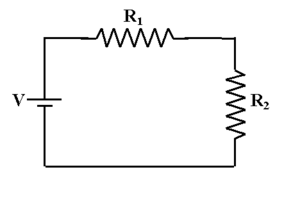Resistors and Conductivity
A resistor is a component of a circuit that acts to reduce both the flow of current and the voltage levels within the circuit. When current runs through a resistor, the energy stored within particles is converted to another form of energy, typically indicated by the emission of light or heat. Conductivity is a property of a given material that refers to the material's ability to transmit electricity. Conductivity and resistivity are opposites; that is, the higher the conductivity of a material, the less resistance it offers to the flow of current.
Relevant Equations
The resistance of a material can be calculated in several ways. The most common method relates resistance to the potential difference and the conventional current of the circuit, using the equation [math]\displaystyle{ R = {\frac{ΔV}{I}} }[/math] where ΔV is the potential difference across the resistor and I is the conventional current running through the circuit.
The conductivity of a material can be found using the equation [math]\displaystyle{ σ = |q|nu = {\frac{\vec{J}}{\vec{E}}} }[/math] where |q| is the absolute value of the charge on each carrier, n is the number of charge carriers per m3, and u is the mobility of the charge carriers, J is the current density (I/A) in A/m2, and E is the electric field due to charges outside the material.
Another equation used to quantify resistance relates it to certain properties of the material and geometric properties of the resistor itself: [math]\displaystyle{ R = {\frac{L}{σA}} }[/math] where L is the length of the resistor, σ is the conductivity of the material, and A is the cross-sectional area of the resistor. This equation clearly demonstrates that resistivity and conductivity are inverses, as the conductivity constant can be found in the denominator.
A Computational Model
How do we visualize or predict using this topic. Consider embedding some vpython code here Teach hands-on with GlowScript
Ohmic vs. Non-Ohmic Resistors
Based on the equations above, it is clear that both conductivity and resistance are dependent on the mobility of the charge carriers, and so these values may vary as the current through an object changes. When the conductivity of a material is nearly constant, independent of the amount of current flowing through the resistor, we consider the material and resistor "ohmic." No matter is truly ohmic, as conductivity depends to some extent on temperature, and higher currents often lead to higher temperatures. Materials are generally considered ohmic, however, if the temperature change is minimal.
Symbol
The conventional symbol for a resistor used in electrical circuit diagrams is shown below.
Resistors in Series
When ohmic resistors are connected along a single path with no branches, as in the figure below, they are said to be in series.

Resistors in series are, in practice, equivalent to a single resistor with the combined resistance of its constituent resistors. In other words, [math]\displaystyle{ R_{equivalent} = R_1 + R_2 + R_3 + ... + R_n }[/math] for n resistors in series.
Because R = L/(σA), if every resistor is composed of the same material and has the same cross-sectional area, [math]\displaystyle{ L_{equivalent} = L_1 + L_2 + L_3 + ... + L_n }[/math] for n resistors in series.
Resistors in Parallel
When ohmic resistors are not connected in series, they can be connected in parallel (as in the figure below), creating several branches within a circuit.

Several resistors in parallel are, in practice, equivalent to a single resistor with a resistance that is the reciprocal of the sum of reciprocals of the individual resistances. In other words, [math]\displaystyle{ {\frac{1}{R_{equivalent}}} = {\frac{1}{R_1}} + {\frac{1}{R_2}} + {\frac{1}{R_3}} + ... + {\frac{1}{R_n}} }[/math] for n resistors in parallel.
Because 1/R = (σA)/L, if every resistor is composed of the same material and has the same length, [math]\displaystyle{ A_{equivalent} = A_1 + A_2 + A_3 + ... + A_n }[/math] for n resistors in parallel.
Examples
Be sure to show all steps in your solution and include diagrams whenever possible
Simple
Middling
Difficult
Connectedness
- How is this topic connected to something that you are interested in?
- How is it connected to your major?
- Is there an interesting industrial application?
History
Put this idea in historical context. Give the reader the Who, What, When, Where, and Why.
See also
Are there related topics or categories in this wiki resource for the curious reader to explore? How does this topic fit into that context?
Further reading
Books, Articles or other print media on this topic
External links
Internet resources on this topic
References
This section contains the the references you used while writing this page
